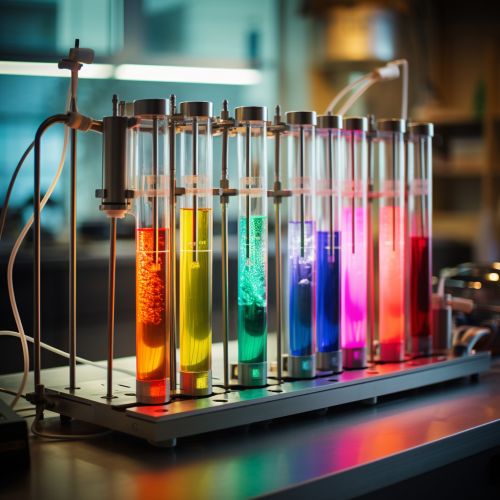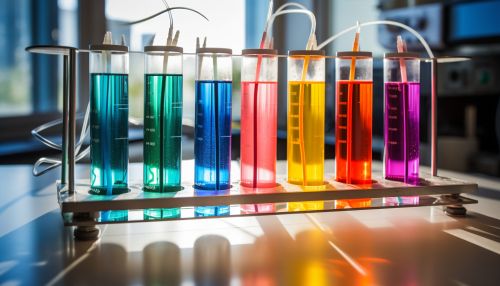Chromatography
Introduction
Chromatography is a laboratory technique for the separation of a mixture into its individual components. The technique is based on the principle that different compounds in a mixture will have different affinities for a stationary phase and a mobile phase, resulting in differential migration and separation of the components. Chromatography can be classified into several types based on the physical state of the phases (gas, liquid, or solid), the method of separation, and the nature of the interactions between the phases. Chromatography is widely used in various fields such as biochemistry, pharmacology, environmental science, and food analysis.


History
The concept of chromatography was first introduced by the Russian botanist Mikhail Tsvet in 1900. He used the technique to separate plant pigments such as chlorophyll and carotenes. The term chromatography, derived from the Greek words "chroma" meaning color and "graphein" meaning to write, was coined by Tsvet to describe his colorful experiments. Over the years, the technique has evolved and diversified, leading to the development of several types of chromatography including paper chromatography, thin layer chromatography, gas chromatography, and high-performance liquid chromatography.
Principles of Chromatography
Chromatography operates on the principle of partitioning, where a mixture is dissolved in a fluid (the mobile phase) which carries it through a structure holding another material (the stationary phase). The various components of the mixture travel at different speeds, causing them to separate. The separation is based on differential partitioning between the mobile and stationary phases. Subtle differences in a compound's partition coefficient result in differential retention on the stationary phase and thus changing the separation.
Types of Chromatography
There are several types of chromatography, each with its unique characteristics and applications. These include:
Gas Chromatography
In gas chromatography, the mobile phase is a carrier gas, usually an inert gas such as helium or an unreactive gas such as nitrogen. The stationary phase is a microscopic layer of liquid or polymer on an inert solid support, inside a piece of glass or metal tubing called a column.
Liquid Chromatography
Liquid chromatography involves a liquid mobile phase to separate the components of a mixture. The stationary phase is either a solid adsorbant, as in high performance liquid chromatography (HPLC), or a liquid on an inert solid support, as in thin layer chromatography (TLC).
Paper Chromatography
In paper chromatography, paper is used as the stationary phase. A drop of the mixture is placed onto a line drawn on the paper, and the edge of the paper is then dipped into a suitable solvent. The solvent moves up the paper by capillary action, carrying with it the components of the mixture.
Thin Layer Chromatography
Thin layer chromatography (TLC) is similar to paper chromatography, but instead of paper, a thin layer of material such as alumina, silica gel, or cellulose on a flat, inert substrate is used.
Affinity Chromatography
Affinity chromatography is based on selective non-covalent interaction between an analyte and specific molecules. It is frequently used in biochemistry, in the purification of proteins bound to tags.
Applications of Chromatography
Chromatography has a wide range of applications in various fields:
Biochemistry
In biochemistry, chromatography is used to separate and analyze complex protein mixtures, nucleic acids, and lipids. It is also used in the study of biological membrane structures, the sequencing of amino acids and carbohydrates, and in the analysis of genetic material.
Pharmacology
In pharmacology, chromatography is used for the analysis of complex mixtures of biological fluids for drug identification and quantification, therapeutic drug monitoring, and the detection of substances in the urine for drug testing.
Environmental Science
In environmental science, chromatography is used to analyze soil and air samples, identify pollutants, and study plant components. It is also used in the study of atmospheric gases and in the detection of global warming pollutants.
Food Analysis
In food analysis, chromatography is used to identify and quantify additives, vitamins, preservatives, proteins, and sugars. It is also used in the detection of pesticides and insecticides in food products.
